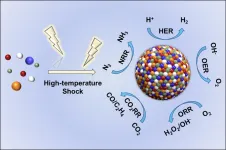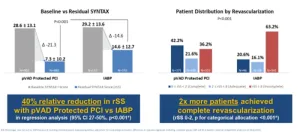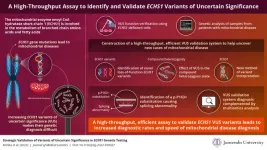(Press-News.org) Children’s Cancer Research Fund has awarded $250,000 to an innovative new approach to treating leukemia – blood cancer – being developed at UVA Cancer Center.
The grant to John H. Bushweller, PhD, of the University of Virginia School of Medicine, is part of the national nonprofit’s efforts to accelerate the development of new and better treatments for difficult-to-treat cancers.
“This funding makes it possible to continue developing a novel approach to treatment for a form of pediatric leukemia with a very poor prognosis,” said Bushweller, of UVA’s Department of Molecular Physiology and Biological Physics. “For pediatric cancers in particular, the development of highly targeted approaches that directly inhibit the protein that drives the cancer has the potential to be more effective and to limit the substantial toxicity of current approaches, vastly improving outcomes for these patients. This is exactly the approach we are pursuing with the support of CCRF.”
Better Leukemia Treatment
Bushweller and his team are developing drugs to block the effect of an abnormal protein that is formed when the protein MLL becomes fused to other proteins and alters the cell, resulting in either acute myeloid leukemia or acute lymphocytic leukemia. Bushweller and his team found in their lab models that blocking the ability of these abnormal proteins to bind to DNA completely prevented it from causing leukemia. Based on those results, they are working to develop drugs that disrupt this DNA binding as a novel approach for treatment.
Based on the promising results so far, Bushweller believes his new approach could be both more effective and less toxic than existing options for treating leukemia. Further, he hopes that the new approach could be combined with existing drugs to provide unique benefits for patients.
“The potential benefits to patients include improved efficacy leading to better outcomes and much reduced toxicity leading to far better quality of life and reduced long-term health effects from the treatment,” he said.
About the Children’s Cancer Research Fund
Children’s Cancer Research Fund is a national nonprofit dedicated to ending childhood cancer. It backs promising research from top scientists across the country, funding projects that could make the greatest impact for children battling cancer. Since 1981, the group has contributed more than $200 million to research, support programs for children and their families and cancer awareness and education outreach efforts.
“At Children’s Cancer Research Fund, we select and fund the best and most innovative research to advance breakthrough treatments for children’s cancer. And we are excited about Dr. Bushweller’s promising results,” said Jean Machart, chief operating officer and interim chief executive officer at Children’s Cancer Research Fund.
About UVA Cancer Center
Developing new and better ways to treat cancers is a primary mission of UVA Cancer Center. In recognition of UVA Cancer Center’s outstanding research and patient care, the National Institute has designated it one of only 54 Comprehensive Cancer Centers in the country. The designation recognizes elite cancer centers with the most exceptional cancer programs in the nation.
To keep up with the latest medical research news from UVA Cancer Center and the rest of UVA Health, including the UVA School of Medicine and the UVA School of Nursing, subscribe to the Making of Medicine blog at http://makingofmedicine.virginia.edu.
END
Children’s Cancer Research Fund backs cutting-edge leukemia research at UVA
2023-05-18
ELSE PRESS RELEASES FROM THIS DATE:
Research to improve quality of stroke care is advancing but gaps exist
2023-05-18
INDIANAPOLIS – Every 40 seconds, someone in the U.S. has a stroke. Every 3.5 minutes, someone in the U.S. dies of a stroke. Stroke patients have multifaceted needs, requiring complicated care delivered by multidisciplinary teams.
In the journal Stroke’s annual review of quality improvement advances in stroke care studies, Regenstrief Institute Research Scientist Dawn Bravata, M.D., and colleagues update researchers, clinicians and healthcare administrators on advances in the field, highlighting the challenges of scalability and sustainability.
“Quality improvement exists to ensure that every patient with stroke or at risk of stroke is getting the care ...
High-temperature shock synthesis of high-entropy alloy nanoparticles for catalysis
2023-05-18
High-temperature shock (HTS) is an emerging synthesis method with kinetics-dominated non-equilibrium characteristics, which can achieve an ultrafast heating/cooling rate of ~10^5 K/s and a peak temperature larger than ~3000 K within a time scale of seconds or milliseconds, and is widely used in the preparation of high entropy content, thermodynamic metastable phase and defect-rich materials. Amongst these significant advances, nanoscale high entropy alloys (HEA) are particularly prominent in heterogeneous catalytic reactions with remarkable ...
Analysis showcases potential for more complete revascularizations with Impella compared to IABP during HRPCI
2023-05-18
DANVERS, Mass., May 18, 2023 – Abiomed, part of Johnson & Johnson MedTech[1], announces results of a third-party analysis showing that utilizing Impella during high-risk percutaneous coronary intervention (PCI) procedures may help physicians achieve a more complete revascularization compared to high-risk PCIs supported using an intra-aortic balloon pump (IABP). Previous studies have shown that a more complete revascularization can lead to longer survival[2],[3], a greater reduction in heart failure and angina symptoms[4], and an improved quality of life for the patient[5].
This analysis shows ...
Novel high-efficiency assay promises rapid mitochondrial disease diagnosis
2023-05-18
The gene ECHS1 encodes for enoyl-CoA hydratase short-chain 1, a mitochondrial enzyme involved in branched-chain amino acid and fatty acid metabolism. Rare inherited mutations in the ECHS1 lead to mitochondrial ECHS1 deficiency, resulting in the disruption of the metabolism of the essential amino acid valine and accumulation of valine intermediates.
In fact, ECHS1 is one of the most common causative genes of mitochondrial diseases. These mutant enzymes also cause brain lesions and severe delays in a child’s psychomotor development, along with elevating blood lactate levels. ECHS1 variants have been reported globally, and many disease-causing ...
A new tool for deforestation detection
2023-05-18
Every second, the planet loses a stretch of forest equivalent to a football field due to
logging, fires, insect infestation, disease, wind, drought, and other factors. In a recently published study, researchers from the U.S. Geological Survey Earth Resources Observation and Science (EROS) Center presented a comprehensive strategy to detect when and where forest disturbance happens at a large scale and provide a deeper understanding of forest change.
The study was published on Feb. 28 in the Journal of Remote Sensing.
“Our strategy leads to more accurate land cover ...
To avoid a battery crisis, more of us should share small, lightweight EVs
2023-05-18
Most global scenarios and governmental targets for decarbonizing the transport sector consider battery-powered electric vehicles as a main part of the solution. Enormous amounts of raw materials are needed to build enough batteries and ensure a transition to low-emission vehicles.
Access to lithium is critical, as it is used in all types of EV batteries.
Future demand needs to decrease
“It seems very likely we'll have a shortage. The key lies in the demand. The demand needs to decrease to avoid long-term supply problems,” ...
Space missions set to improve solar storm forecasts
2023-05-18
Satellites launched into outer space could send back improved warnings of dangerous solar storms thanks to a breakthrough in the way scientists use space weather measurements.
Experts from the University of Reading have found that using satellite data that is less reliable but is returned to Earth rapidly can be used to improve the accuracy of solar wind forecasts - which are harmful streams of charged particles sent from the sun - by nearly 50 per cent.
Their research, published today (Thursday, 18 May) in Space Weather, ...
Perfect ‘pathogen’ storm: Vibrio bacteria, Sargassum and plastic marine debris
2023-05-18
A new study uncovers how the interplay between Sargassum spp., plastic marine debris and Vibrio bacteria creates the perfect “pathogen” storm that has implications for both marine life and public health. Vibrio bacteria are found in waters around the world and are the dominant cause of death in humans from the marine environment. For example, Vibrio vulnificus, sometimes referred to as flesh-eating bacteria, can cause life-threatening foodborne illnesses from seafood consumption as well as disease and death from open wound infections.
Since 2011, ...
The importance of social media in corporate social responsibility
2023-05-18
A new study by Dr. Lucie Kvasničková Stanislavská from Czech University of Life Sciences, Prague published in PeerJ Computer Science titled ‘Global analysis of Twitter communication in corporate social responsibility area: sustainability, climate change, and waste management’ has found that social media is an increasingly important tool for companies to communicate their corporate social responsibility (CSR) efforts. The study analyzed over half a million tweets from 2017 to 2022 and identified the key topics and trends communicated in connection with CSR on Twitter.
“Our results aid enterprises in developing communication ...
SCAI releases guidance on management of in-stent restenosis and stent thrombosis
2023-05-18
PHOENIX (May 18, 2023) – The Society for Cardiovascular Angiography & Interventions (SCAI) today release an expert consensus on the management of in-stent restenosis and stent thrombosis. The statement was published online in the Journal of the Society for Cardiovascular Angiography &
Interventions (JSCAI).
In-stent restenosis is a blockage or narrowing that comes back in the portion of the coronary artery previously treated with a stent and remains a common clinical problem despite numerous improvements in stent design and polymer coatings in recent years. In addition to significant health care
costs, it is also associated with an increased risk of death and re-hospitalization. ...







